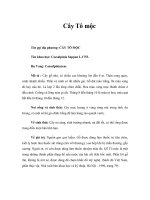Tài liệu Travel to Bath pdf
Bạn đang xem bản rút gọn của tài liệu. Xem và tải ngay bản đầy đủ của tài liệu tại đây (4.25 MB, 40 trang )
Download free ebooks at bookboon.com
Download free ebooks at bookboon.com
Bath
© 2010 Stig Albeck & Ventus Publishing ApS
All rights and copyright relating to the content of this
book are the property of Ventus Publishing ApS, and/or its
suppliers. Content from ths book, may not be reproduced
in any shape or form without prior written permission from
Ventus Publishing ApS.
Quoting this book is allowed when clear references are made,
in relation to reviews are allowed.
ISBN 978-87-7061-485-6
2nd edition
Pictures and illustrations in this book are reproduced according
to agreement with the following copyright owners:
Stig Albeck, Inga Albeck, Wikipedia.
The stated prices and opening hours are indicative and may
have be subject to change after this book was published.
Download free ebooks at bookboon.com
Bath
4
Kapiteloverskrift ONLIBRI
Download free ebooks at bookboon.com
Bath
5
A visit to Bath
A visit to Bath
www.visitbath.co.uk
The city of Bath is not one of the largest cities in
England, but certain to be one of the cities that makes
the largest impression on visitors. A visit to the city
centre is like going back to the 18th century Georgian
period when architects and building owners
transformed Bath from a relatively ordinary provincial
town to a famous spa resort in a matter of years.
Bath is the site of the only natural hot spring in the
British Isles, which was appreciated as early as in the
Roman period, and much of the city's life has taken
place around the hot spring. Today, you can see the
Romans' old bath as well as diving in to the hot
water yourself.
Bath is located in a valley at the winding course of
the River Avon, and the surrounding
neighbourhood offers unforgettable experiences of
nature and historical value.
Enjoy your stay!
Download free ebooks at bookboon.com
Bath
6
Historical Outline
Historical Outline
The city of Bath has its root in the period before the
Roman Age when the Celtics came to the hot spring
to honour the goddess Sulis. The Romans arrived in
England in the year43, and they quickly gained
control of the southern part of the country and thus
also Bath, which they called Aquae Sulis. The building
of the Roman Baths took place in the years 60-70,
and is still visible proof of this period. At that time,
the Romans had also built temples for the Celtics'
Sulis and the Roman's Minerva, and a community had
been developed. After the Roman withdrawal from
the British Isles in 407, Bath's history is not known in
details, but it is presumed that people still lived in the
Roman constructions; however, the large complexes
such as the Bath became dilapidated.
The Saxons arrived, and in the 800s so-called
Burghs were established. Burghs were fortified
cities, which were going to guard against possible
attacks from the Danish Vikings. Bath was one of
those cities and that strengthened the city's status as
a regional centre. Despite its relatively small size,
Edgar, the first king to govern all of England, was
crowned in Bath in 973.
In 1088, Bath witnessed a riot where the city was
partly burnt down. However, it was quickly rebuilt.
In the following century, the Bishop moved here
and the building of Bath Abbey was begun. It
became one of the city's dominating institutions
during the Middle Ages. In 1189, Bath received its
first city rights. In the Middle Ages, the
predominant industry of the area was wool and the
textile production, which naturally followed.
In 1539, King Henry VIII closed the city's convent,
and most of the buildings were torn down. Bath
Abbey remained, but in the following decades it fell
into decay due to the vacuum the closing of the
convent created. In the 1500s, the wool and textile
production began to decrease. Instead, tourism began
to flow to the city's hot spring, which supposedly
has a curative effect.
From 1590, with the new city rights bestowed
upon the city by Queen Elizabeth I, the city
began to prosper again. A mayor was installed,
new buildings initiated, and the streets were
cleaned-up. However, the improved hygienic
conditions did not prevent the plague epidemic
from striking the cities. The disease struck Bath
in 1604, 1625, 1636, and 1643.
In the 1700s, Bath became a fashionable place,
and people and money flocked to the city, which
experienced the beginning of a flourishing period
of growth with a large increase in the number of
inhabitants, and the construction of many of the
grand buildings you can see in Bath today; The
Circus, Royal Crescent, Pump Room, Pulteney
Bridge, and Assembly Rooms. Institutions were
founded - a hospital in 1742 and the first bank in
1768 are just a few examples. In 1718, a
programme began which cleaned, paved, and lit
the streets. It was a booming period for Bath, and
each summer well-to-do tourists filled the city.
In the beginning of the 1800s, more than 30,000
people inhabited Bath, a considerable number by
the standards of that time. Bath was a significant
city, but even though the number of inhabitants
doubled during the century, it was now the new
industrial cities of the Midlands, which attracted
people as well as investments. Bath was once
again a provincial town, but now a very beautiful
and fashionable one. The railway from Bristol
opened in 1840, and the following year you could
ride to London as well. This made the continued
development of the tourism much easier. In the
1880s, the old Roman baths were rediscovered
and this created new interest in Bath.
Download free ebooks at bookboon.com
Please click the advert
Bath
7
Historical Outline
Through the 1900s, tourism developed continually,
and is today the primary source of income for the city.
During the Second World War, the city was bombed,
but the city was quickly rebuilt after the war.
A variety of museums opened in the latter half of
the 20th century, which strengthened the tourist
industry, as it gave the tourists even more things to
see, in addition to the Roman Baths and the
beautiful and harmonious town plan and buildings
of the unique town centre.
Download free ebooks at bookboon.com
Bath
8
Tour 1: Bath
Tour 1: Bath
1. Bath Abbey
Orange Grove
www.bathabbey.org
The beautiful Bath Cathedral is one of the most
famous church buildings in England. It was founded
in the 600s, but the current Gothic building was
built several centuries later and finally completed in
the 1530s.
The church was an abbey church until 1539 when
the British convents were transferred and Bath
Abbey was passed over to the Crown. Valuables
were removed from the church, which was left to
fall into decay until 1874 when Queen Elizabeth I
started a restoration. After the restoration, Bath
Abbey became an Anglican parish church.
In the 1860s, the church was thoroughly restored
and the originally intended vaulted ceilings were
established.
In Bath Abbey, you will find a number of monuments
for different people, for instance the Bishop of Bath
and Wells, James Montague, and Arthur Philip, the
first governor in the colony, New South Wales.
In connection to Bath Abbey, you will find an
interesting crypt museum, Bath Abbey Heritage
Vaults, where you get an interesting retrospect of
the history of Bath and Bath Abbey.
2. Roman Baths
Stall Street
www.romanbaths.co.uk
Bath’s most famous attraction is the great and
impressive Roman baths, founded on the only hot
spring in the British Isles in the years 60-70. The
large grounds are excavated and very well
preserved. The present buildings, which constitute
the visitor's centre, are primarily established in the
latter half of the 18th century. They are very
beautiful on their own.
As a visitor, you walk on the original Roman
floors. You can see the rebuilding of the large
baths, the rooms themselves, and a fine
exhibition, which contains a large model of the
entire Roman Bath.
In the beautiful restaurant, the Pump Room, you
can even taste the warm spring water, which is
rich in minerals. The water begins as rainwater in
the Mendip Hills before it reaches the spring.
From the Mendip Hills the water runs to a depth
of 2,700-4,300 metres where geothermic energy
heats it up to ca. 64-96 degrees Celsius. Through
cracks in the subsurface, the water surfaces with
a temperature of 46 degrees Celsius.
Download free ebooks at bookboon.com
Bath
9
Tour 1: Bath
3. Sally Lunn’s House
4 North Parade Passage
www.sallylunns.co.uk
This is one of the more extraordinary, but
recommendable attractions of the city. It is a
restaurant, which carries the name of the
Frenchwoman Sally Lunn, who came to England
more than 300 years ago. She brought with her a
recipe for the lovely buns now known as Sally
Lunn’s Buns. The buns are used for all of the
restaurant’s meals, for instance as a ‘plate’ beneath
the meat dishes and as a sweet dessert with fruit.
One ought to visit this establishment, which is
located in the oldest residential building of Bath.
The atmosphere of the small rooms is wonderful
and you can end your visit with a trip to the
basement museum, where the kitchen from the
1100s is still preserved.
4. Thermae Bath Spa
Bath Street
www.thermaebathspa.com
In Thermae Bath Spa you can bath in the hot
spring water of Bath. The modern centre opened
in 2006, and today the centre offers a long
number of wellness services in addition to the
bath itself. At the roof, there is an outdoor
swimming pool, which offers a lovely view of the
city centre.
5. Theatre Royal
Sawclose
www.theatreroyal.org.uk
Bath's Theatre Royal was founded in 1805 and
has been one of the leading theatres of England,
outside London, ever since.
The present entrance building was built in 1720
as a residence, while the theatre building behind
was finished in 1805. The interior is brilliantly
decorated and is one of the finest examples of
Georgian architecture in Bath.
Download free ebooks at bookboon.com
Please click the advert
Bath
10
Tour 1: Bath
© Deloitte & Touche LLP and affiliated entities.
360°
thinking
.
Discover the truth at www.deloitte.ca/careers
© Deloitte & Touche LLP and affiliated entities.
360°
thinking
.
Discover the truth at www.deloitte.ca/careers
© Deloitte & Touche LLP and affiliated entities.
360°
thinking
.
Discover the truth at www.deloitte.ca/careers
© Deloitte & Touche LLP and affiliated entities.
360°
thinking
.
Discover the truth at www.deloitte.ca/careers
Download free ebooks at bookboon.com
Bath
11
Tour 2: Bath
Tour 2: Bath
6. Green Park Railway Station
Green Park Road
www.greenparkstation.co.uk
Green Park Railway Station is a closed-down railway
station, which was built in 1870 as the terminus for the
branch line between Bath and Mangotsfield. It was
originally named Queen Square Station, and the style is
beautifully adapted to Bath's Georgian architecture.
The passenger train service stopped in 1966 and five
years later the freight train service ended as well. Thus,
the station closed down and has since functioned as
super market, market hall and car park.
Today, the trains to Bath arrive at Bath Spa Station,
which was established in 1840.
7. Herschel Museum of Astronomy
19 New King Street
www.bath-preservation-trust.org.uk
A visit to the Herschel Museum of Astronomy is
a visit to a completely restored Georgian town
house. It was the home of the astronomer and
musician William Herschel and his sister,
Caroline.
The German-born Herschel is famous for having
discovered the planet, Uranus, in 1781 during his
time in Bath. In the formal garden of the museum,
you can see one of Herschel's telescopes. The
house is also interestingly and beautifully
decorated, and naturally tells the story of Herschel,
the Universe, and the history of the place.
Download free ebooks at bookboon.com
Bath
12
Tour 2: Bath
8. Queen Square
Queen Square
Queen Square is one of the squares in Bath where you
can see Georgian houses and town planning by the
architect, John Wood the Elder who owned a house
here himself. The northern part of the square is the
oldest part of the square; established in the first half of
the 18th century, while the houses in the western part
of the square are of a 100 years later date and are built
in a different style than intended by John Wood.
In the middle of the green space of Queen Square is
an obelisk erected in 1738.
9. Jane Austen Centre
40 Gay Street
www.janeausten.co.uk
The author Jane Austen is perhaps Bath's most famous
fellow-townsman. In the museum, Jane Austen Centre,
you can read more about her and get a good
impression of her age and how Bath inspired her work.
Jane Austen lived from 1775 to 1817 during the
so-called Regency period, with its style between
the Georgian and Victorian styles.
10. Bath Postal Museum
27 Northgate Street
www.bathpostalmuseum.co.uk
The Bath Postal Museum has a permanent
exhibition about the different aspects of postal
history, and always offers fine anecdotes and
artefacts from the postal evolution. It also
arranges theme exhibitions about specific topics.
The Postal Museum was founded in 1979 and
was, at one time, located at 8 Broad Street, the
site of the city's post office in the years 1822-
1854. The old post office is historic; it was from
here the world's first stamped letter was sent on
2 January, 1840. It was four days before the
official date of publication.
Download free ebooks at bookboon.com
Please click the advert
Bath
13
Tour 2: Bath
11. St. Michael’s Church
Broad Street/Northgate Street
St. Michael's Church is a parish church, which
dominates the street scene around Northgate
Street in the centre of Bath. It is the third church
on the site.
After the medieval church, a cupola church in
Georgian style was established between 1734 and
1742. The present church is from the years 1835-
1837.
Increase your impact with MSM Executive Education
For more information, visit www.msm.nl or contact us at +31 43 38 70 808
or via
the globally networked management school
For more information, visit www.msm.nl or contact us at +31 43 38 70 808 or via
For almost 60 years Maastricht School of Management has been enhancing the management capacity
of professionals and organizations around the world through state-of-the-art management education.
Our broad range of Open Enrollment Executive Programs offers you a unique interactive, stimulating and
multicultural learning experience.
Be prepared for tomorrow’s management challenges and apply today.
Executive Education-170x115-B2.indd 1 18-08-11 15:13
Download free ebooks at bookboon.com
Bath
14
Tour 2: Bath
Download free ebooks at bookboon.com
Bath
15
Tour 3: Bath
Tour 3: Bath
12. Parade Gardens
Orange Grove
Bath City Park is a wonderful green oasis along the
Avon River in the centre of Bath. From here, you
can enjoy a brilliant view of Pulteney Bridge and
Bath Abbey.
13. Guildhall
High Street
www.bathvenues.co.uk
Guild is one of the great monumental buildings in
the centre of Bath. Today, the building is used for
various parties and events. The two most impressive
rooms of Guildhall is the Council Chamber and the
Banqueting Room.
14. Victoria Art Gallery
ved Pulteney Bridge
www.victoriagal.org.uk
In the art museum, Victoria Art Gallery, you can
see works by British oil painters from the 1600s
to today. You can see works by Gainsborough
and Sickert. The exhibition also displays pictures
from Bath throughout the centuries and various
artefacts.
Download free ebooks at bookboon.com
Please click the advert
Bath
16
Tour 3: Bath
15. Pulteney Bridge
Pulteney Bridge
Pulteney Bridge spans the Avon River and is the
only bridge in the world where shopping arcades are
built on the bridge itself in its entire length.
The bridge was completed in 1773 and is named
after Frances Pulteney, who inherited the Bathwick
Mansion and the land belonging to ii in 1767. The
land was located east of the river. Pulteney wished
to create a new quarter in the city, and saw a stately
bridge from the Bath centre as a prerequisite.
The bridge is designed by Robert Adam with
inspiration from the Rialto Bridge in Venice and
Ponte Vecchio in Florence as well as Andrea
Palladio's suggestion for a non-realised Rialto
Bridge. Adam primarily followed the lines in
Palladio's suggestion for the design of the
Pulteney Bridge.
Floods in 1799 and 1800 destroyed the north
side of the bridge, which lacked a strong
foundation. It was rebuilt, but in a less grand
version than Adam's version, which can be seen
to the south. Later, the north side has had small
additions, but this cannot be seen from walking
across the bridge, which seems like a normal
street.
Get “Bookboon’s Free Media Advice”
See the light!
The sooner you realize we are right,
the sooner your life will get better!
A bit over the top? Yes we know!
We are just that sure that we can make your
media activities more effective.
Download free ebooks at bookboon.com
Bath
17
Tour 3: Bath
16. Holburne Musem of Art
Sydney Place
www.bath.ac.uk/holburne
At the end of the beautifully designed Great Pulteney
Street, lies the Holburne Museum of Art. It is located
in the 18th century hotel, Sydney Hotel, which is
situated next to the green area Sydney Gardens.
The collection of the museum consists of a wide
range of fine art works, handicrafts, and household
effects, including paintings, sculptures, furniture,
and porcelain. In addition to the permanent
collection, the place arranges different exhibitions.
17. Bath Locks
E.g. at Rossiter Road and Pulteney Gardens
In the centre of Bath, you can see a lot of locks; the
most central is number 7, which is also called Bath
Bottom Lock. This lock forms the beginning of the
Kennet and Avon Canal, which connects the rivers
Kennet at the city of Newbury and Avon at Bath. The
92 kilometres long canal opened in 1810 and
functioned as a communication to the River
Thames. Thus, the system created a connection
between London and the significant port of Bristol.
There are seven locks in Bath. The numbers go
from 7, Bath Bottoms Lock, to number 13, Bath
Top Lock. At both the locks and along the canal,
you can get an impression of British canal life.
Just a few kilometres southeast of Bath, you can
see some of the most interesting places along the
canal; the aqueducts Dundas and Avoncliff. Both
cross the canal and thus the canal boats on a
bridge across the river Avon. At Dundas, the
small canal Somerset Coal Canal breaks away.
Download free ebooks at bookboon.com
Bath
18
Tour 3: Bath
Download free ebooks at bookboon.com
Please click the advert
Bath
19
Tour 4: Bath
Tour 4: Bath
18. The Building of Bath Museum
Paragon
www.bath-preservation-trust.org.uk
In this museum, you can experience the interesting
history of Bath's transformation from a normal
provincial town to an architectural gem and world-
renowned spa resort.
It focuses on architecture in several ways; where
did the inspiration come from, what materials are
used, who was in charge of the planning, and
much more. It is all spiced with models and
many effects from Bath's construction and
decoration background.
19. Museum of Bath at Work
Julian Road
www.bath-at-work.org.uk
The Museum of Bath at Work produces different
aspects of Bath's trade-, production-, and work
life. The museum building is the former
workshop and office of the businessman J.B.
Bowler's company.
GO T -THE-ENERGY-T O-LEAD.C OM
We believe that energy suppliers should be renewable, too. We are therefore looking for enthusiastic
new colleagues with plenty of ideas who want to join RWE in changing the world. Visit us online to find
out what we are offering and how we are working together to ensure the energy of the future.
Download free ebooks at bookboon.com
Bath
20
Tour 4: Bath
Among the industries portrayed in the museum is
the breaking of the stones Bath is built by, and the
furniture production, which came into existence in
the city's period of growth in the 1700s.
20. Bath Assembly Rooms
Bennett Street
www.nationaltrust.org.uk
www.bathvenues.co.uk
In Bath, as in many other British cities, Assembly
Rooms have been built throughout time. Assembly
Rooms were places where the well-to-do citizens
could meet for different occasions such as a ball or
card playing.
The building, which has several beautifully
decorated halls, is built in 1769-1771. Today, a
section of the building houses the Fashion Museum,
and a section can be rented for private arrangements.
20a. Bath Fashion Museum
www.fashionmuseum.co.uk
In the beautiful interior of Bath Assembly Hall, you
will find the Fashion Museum. The museum was
founded in 1963 and based on the collector Doris
Langley Moore's costume collection. The rich
collection focuses on clothing and fashion from
1600 to today.
21. Museum of East Asian Art
12 Bennett Street
www.meaa.org.uk
This museum exhibits different art works and
articles for everyday use from the Southeast Asian
countries. You can see a large collection of
Chinese jade and ceramics from different
countries. The museum is founded in 1993 and is
based on the collection Brian McElney established
during 35 years residence in Hong Kong.
Download free ebooks at bookboon.com
Bath
21
Tour 4: Bath
22. The Circus
The Circus
The square, The Circus, lies as a circle surrounded
by grand Georgian buildings. There are three rows
of houses, which are built in the period 1754-1768.
The houses consists of three equally long parts of a
circle, and complete the strict symmetry the square
is designed after.
The Circus is designed by the architect John Wood
the Elder and was part of his plan for creating a
Bath centre with numerous buildings in the
symmetric Palladian style, which was one of the
most used styles in the Georgian era in England.
Only Queen Square and The Circus were completed.
23. Royal Crescent
1 Royal Crescent
www.bath-preservation-trust.org.uk
Royal Crescent is a row of 30 identical houses built
in a sector of a circle as it is seen in several places in
England. The houses were built in the years 1767-
1774, and are considered to be the finest
Georgian buildings in the country, and are some
of the most beautiful in Palladian style in Bath.
The easternmost house, number 1, is a museum
exhibiting the interior of a middle-class home,
which the house at Royal crescent was, of the
time.
24. Royal Victoria Park
Royal Avenue/Cotswold Way/Weston Road
Royal Victoria Park is named after the future
Queen Victoria, who opened the park in 1830
when she was an 11-year-old princess. An
obelisk is erected in her honour in the park.
The park is full of recreational possibilities;
everything from walks on the open lawns and
golf to a visit to the botanical gardens in the
western end of the park. In the garden, you will
find the Temple of Minerva, which was re-
established here in 1926 after having been
constructed in London two years earlier as a part
of the British Empire Exhibition.
Download free ebooks at bookboon.com
Please click the advert
Bath
22
Tour 4: Bath
Contact us to hear more
Who is your target group?
And how can we reach them?
At Bookboon, you can segment the exact right
audience for your advertising campaign.
Our eBooks offer in-book advertising spot to reach
the right candidate.
Download free ebooks at bookboon.com
Bath
23
Day Trips from Bath
Day Trips from Bath
25. Prior Park Landscape Garden
Ralph Allen Drive, 2 km SE
www.nationaltrust.org.uk/priorpark
Prior Park is a British landscape garden where you
can take beautiful walks on forest or lawn paths.
There are several fine views of Bath and the hilly
country surrounding the city.
The local contractor and philanthropist Ralph Allen
laid out the park in the years 1734-1764. It was laid
out next to the stately mansion south of the park.
The mansion is designed by John Wood the Elder,
and was the home of Ralph Allen. Since 1830, the
building has housed a Catholic college.
The park also includes another structure; the famous
decorative bridge, which is one of the world's only
Palladian style bridges.
26. Beckford’s Tower
Lansdown Road, 3 km N
www.bath-preservation-trust.org.uk
Beckford's Tower was designed in 1825 and
completed for William Beckford two years later.
The 36 metre high tower functioned partly as study
and partly as repository for William Beckford's art
collection.
The tower is now a museum, which exhibits
original furniture from the place, and presents
the story of the author and patron of art, William
Beckford. The top of the tower offers a
magnificent view.
27. The American Museum in Britain
Claverton Manor, Claverton, 6 km E
www.americanmuseum.org
This museum portrays America's history during
and after the British colonial period. The focus is
primarily on the 1600-1800s. Among other
things, it tells the story of the foundation of the
North American colonies and the American Civil
War. The many artefacts, furniture, and porcelain
Download free ebooks at bookboon.com
Bath
24
Day Trips from Bath
form one of the finest collections outside America.
The museum was founded in 1961 and established in
the Claverton Manor mansion, which is built in
Georgian style in 1820. In the museum park, the
Mount Vernon Garden is established. It is inspired by
the first American president, George Washington's
garden in his home Mount Vernon in Virginia, USA.
28. Wells
Wells, 35 km SW
www.wells.gov.uk
By British standards, the city of Wells is relatively small
with its only 10,000 citizens, but it attracts many
visitors due to its status as a former Episcopal
residence. In addition to the famous sights, the central
streets of the cities, such as Sadler Street, Vicars Close,
and Market Place are very charming to stroll in.
28a. Wells Cathedral
Cathedral Green
www.wellscathedral.org.uk
Wells Cathedral is episcopal residence for the cities
and areas Bath and Wells, and the first church at the
site dates back to the year 705. The present building
is primarily built from 1175 and to the opening
in 1239; however, few alterations were made
during the following centuries.
The 30 metre high, beautiful western façade was
finished in 1260, and is richly decorated with more
than 300 preserved figurines in various recesses.
The beautiful extension, the Chapter House, was
completed in 1306. Later, during the 1300s and
1400s, the two towers to the west were added. In
the latter half of the 15th century, the building was
completed in the appearance it has today.
Inside, the Wells Cathedral has three naves and a
special inward turned vault construction, which was
established to prevent a collapse of the central
tower. The stained glass windows in the cathedral
are some of the best preserved from Medieval
England. The oldest windows, which are from the
1820s, are the ones immediately to the left of the
stairs to Chapter House.
28b. Bishop’s Palace
Entrance from Market Place
www.bishopspalacewells.co.uk
Since the assumed beginning of the building in
1210, the bishops of Wells have lived in Bishop's
Palace. However, parts of the buildings are now
used for different public purposes and not
merely as the home of the bishop.
From the entrance on Market Place, you go
through two fortress-like gatehouses before you
come to the actual Bishop's Palace. The large
inmost gatehouse was built in 1341. You can also
see the moat surrounding Bishop's Palace.
Download free ebooks at bookboon.com
Please click the advert
Bath
25
Day Trips from Bath
29. Bristol
Bristol, 20 km NW
www.bristol.gov.uk
Through the many recent centuries, Bristol has
been one of England's leading economical and
cultural cities, which has resulted in a number of
interesting attractions. Especially the trade along
the river has left its mark during the last few
hundred years, and the artificial river port,
Floating Harbour, is now the setting of a lot of
culture, promenades, and a nice atmosphere.
Only the most significant attractions are
mentioned below.
THE BEST MASTER
IN THE NETHERLANDS









